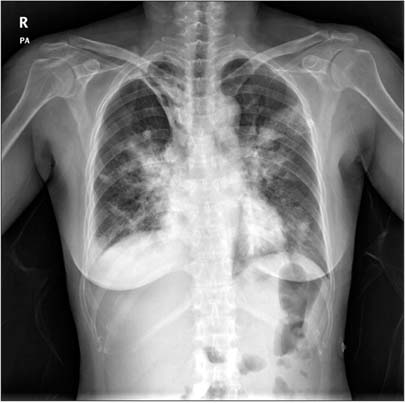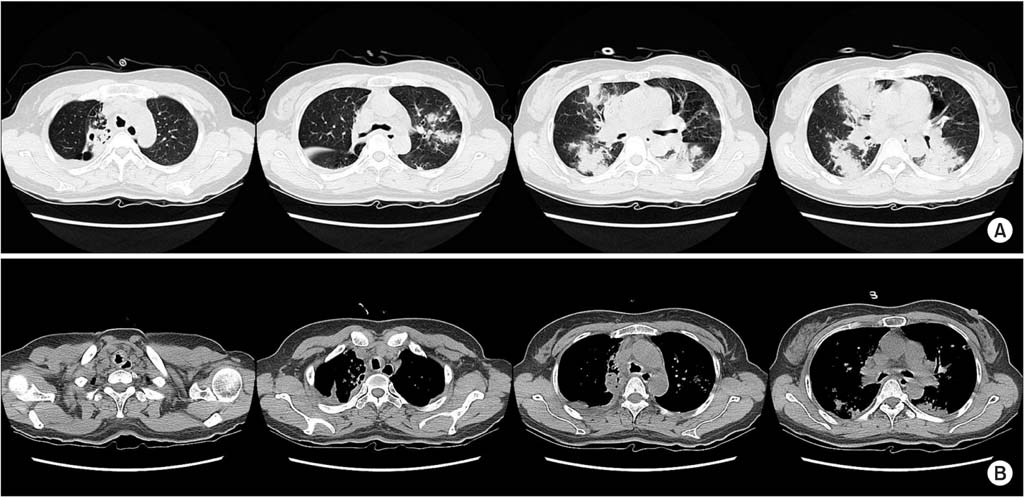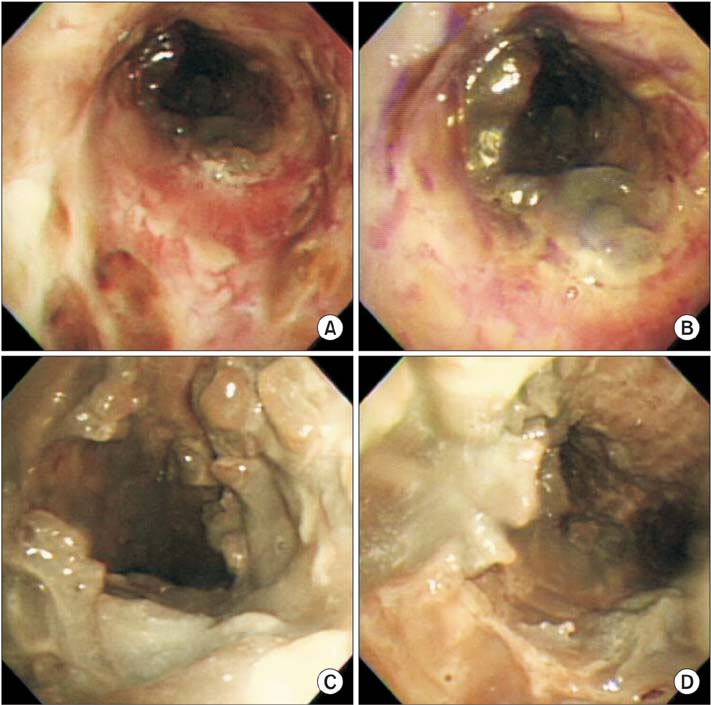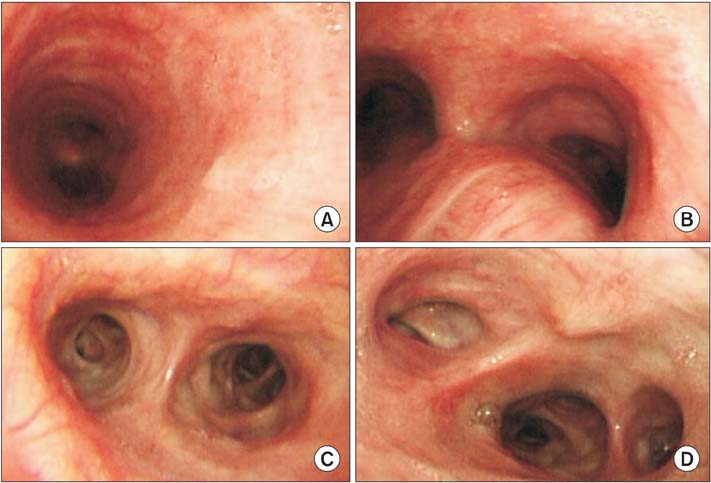Tuberc Respir Dis.
2015 Oct;78(4):366-370. 10.4046/trd.2015.78.4.366.
A Case of Severe Pseudomembranous Tracheobronchitis Complicated by Co-infection of Influenza A (H1N1) and Staphylococcus aureus in an Immunocompetent Patient
- Affiliations
-
- 1Division of Pulmonology, Department of Internal Medicine, St. Vincent's Hospital, College of Medicine, The Catholic University of Korea, Suwon, Korea. chihongk@catholic.ac.kr
- KMID: 2320708
- DOI: http://doi.org/10.4046/trd.2015.78.4.366
Abstract
- Although influenza A (H1N1) virus leads to self-limiting illness, co-infection with bacteria may result in cases of severe respiratory failure due to inflammation and necrosis of intra-airway, as pseudomembranous tracheobronchitis. Pseudomembranous tracheobronchitis is usually developed in immunocompromised patients, but it can also occur in immunocompetent patients on a very rare basis. We report a case of pseudomembranous tracheobronchitis complicated by co-infection of inflenaza A and Staphylococcus aureus, causing acute respiratory failure in immunocompetent patients.
Keyword
MeSH Terms
Figure
Reference
-
1. World Headth Organization. World now at the start of 2009 influenza pandemic [Internet]. Geneva: World Health Organization;2009. cited 2015 Mar 1. Available from: http://who.int/mediacentre/news/statements/2009/h1n1_pandemic_phase6_20090611/en/index.html.2. Korea Centers for Disease Control and Prevention. H1N1 influenza A (H1N1) press release [Internet]. Seoul: Korea Centers for Disease Control and Prevention;2009. cited 2015 Mar 1. Available from: http://www.cdc.go.kr/.3. McCullers JA. Insights into the interaction between influenza virus and pneumococcus. Clin Microbiol Rev. 2006; 19:571–582.4. Brundage JF. Interactions between influenza and bacterial respiratory pathogens: implications for pandemic preparedness. Lancet Infect Dis. 2006; 6:303–312.5. Smith CB, Kanner RE, Golden CA, Klauber MR, Renzetti AD Jr. Effect of viral infections on pulmonary function in patients with chronic obstructive pulmonary diseases. J Infect Dis. 1980; 141:271–280.6. Talwar A, Patel N, Omonuwa K, Lisker G. Postintubation obstructive pseudomembrane. J Bronchol. 2008; 15:110–112.7. Nam KH, Hong JS, Hong MY, Lim JM, Kim MH, Jung BH, et al. A case of pseudomembranous tracheobronchitis complicated by coinfection of 2009 pandemic influenza A/H1N1 and Staphylococcus aureus. Infect Chemother. 2011; 43:425–428.8. Jain S, Kamimoto L, Bramley AM, Schmitz AM, Benoit SR, Louie J, et al. Hospitalized patients with 2009 H1N1 influenza in the United States, April-June 2009. N Engl J Med. 2009; 361:1935–1944.9. Chertow DS, Memoli MJ. Bacterial coinfection in influenza: a grand rounds review. JAMA. 2013; 309:275–282.10. Tashiro M, Ciborowski P, Klenk HD, Pulverer G, Rott R. Role of Staphylococcus protease in the development of influenza pneumonia. Nature. 1987; 325:536–537.11. Namba Y, Mihara N, Tanaka M. Fulminant tracheobronchitis caused by methicillin-resistant Staphylococcus aureus (MRSA). Nihon Kyobu Shikkan Gakkai Zasshi. 1997; 35:969–973.12. Herrmann RE, Ogura GI, Johnson ES, Toll HW Jr, White WC. Respiratory deaths associated with Asian influenza epidemic: report of twenty-three cases. J Am Med Assoc. 1958; 166:467–471.
- Full Text Links
- Actions
-
Cited
- CITED
-
- Close
- Share
- Similar articles
-
- A Case of Pseudomembranous Tracheobronchitis Complicated by Coinfection of 2009 Pandemic Influenza A/H1N1 and Staphylococcus aureus
- A Case of Novel Influenza A (H1N1) Virus Pneumonia Complicated Pnemomediastinum and Subcutenous Emphysema
- Pseudomembranous Aspergillus Tracheobronchitis: Case Report of a Rare Manifestation of Airway Invasive Aspergillosis
- Influenza Associated Pneumonia
- Encephalitis Induced by 2009 H1N1 Influenza A






